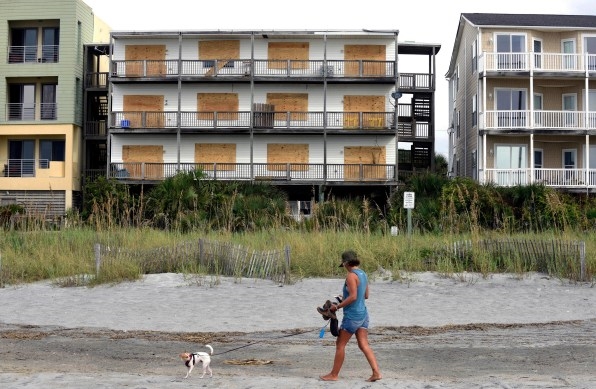Bob Emory can see the waters rise from the condo he shares with his wife in New Bern, North Carolina. All afternoon on Thursday, he watched the Trent River climb six feet and higher, steady rain pounding his neighborhood. Emory feels safe for now, since his apartment sits above a garage, high over the water. But he’s worried about his neighbors closer to the coast.
Emory should know. He was the chairman of a state coastal commission that issued a dire report in 2010, finding that sea levels could rise 39 inches by 2100 and demolishing valuable real estate on the coast. Rather than jolt the state into action, such as revamping the building codes and discouraging development in vulnerable areas, the report had the opposite effect, scaring the state’s politicians and business leaders into passing a law that “effectively ordered state and local agencies that develop coastal policies to ignore scientific models showing an acceleration in the rise of sea levels.” As a result, to ostensibly protect property values, most communities in the state allowed unchecked development on its delicate coastline.
“Our intent with that 2010 report was not to dictate what they did, but to provide information,” Emory tells Fast Company. “If development is going on that is likely to be impacted by hurricanes, you probably don’t want to put 20-story hotels there.”

But real estate developers seem more concerned about profits, and that’s a disincentive to putting up buildings that exceed the building codes, even in the wake of the destruction of massive hurricanes in the region like Maria, Harvey, Irene, and Katrina. “There’s very little new construction to exceed the code requirements,” says Keith Porter, a research professor in civil, environmental, and architectural engineering at the University of Colorado, Boulder. “Most developers and owners are going to own it for a very short time, and say they can’t afford to spend the money on such changes when the guy next door isn’t doing the same. It’s just not competitive for them.”
Because the building codes offer minimum requirements, developers adhere to those and don’t go any further because it will increase costs. And it creates a vicious cycle: Since your competitors are doing it that way, why are you going to imperil your business by spending more to exceed the code? “The short-term interests of decision makers conflict with the long-term interests of society,” says Porter, who notes that it’s actually more cost-effective to build more safely. According to a recent study he conducted, putting up coastal buildings one story above the base flood elevation, which is the minimum height you can build at, according to FEMA, would save $7 for every dollar spent.
After the pro-developers’ law passed in the wake of Emory’s report, not every community let development run rampant. “There are a number of communities that are adjusting their development standards to add another foot or two of [height above the flood elevation],” says Emory, adding that most of them cited flooding rather than climate change as as the reason for the changes. “Most communities wouldn’t call that a reaction to sea-level rise, but the two are not unrelated.” He says that there’s also an incentive in the federal flood insurance program to pay reduced rates if development is more hurricane-resistant.
Farther down the coast, not many such changes have been implemented. “I was in Charleston, South Carolina, a couple years ago, and I saw new developments right next to rivers,” says Porter. “We know that those houses will not live out a full life–because some didn’t think that climate change was real, or that sea-level rise wouldn’t be as dramatic. It may take 10 to 20 years before these lessons are learned the hard way. Part of my job is to scream and holler about this. It’s going to take a lot of people just like me screaming about it.”
(22)